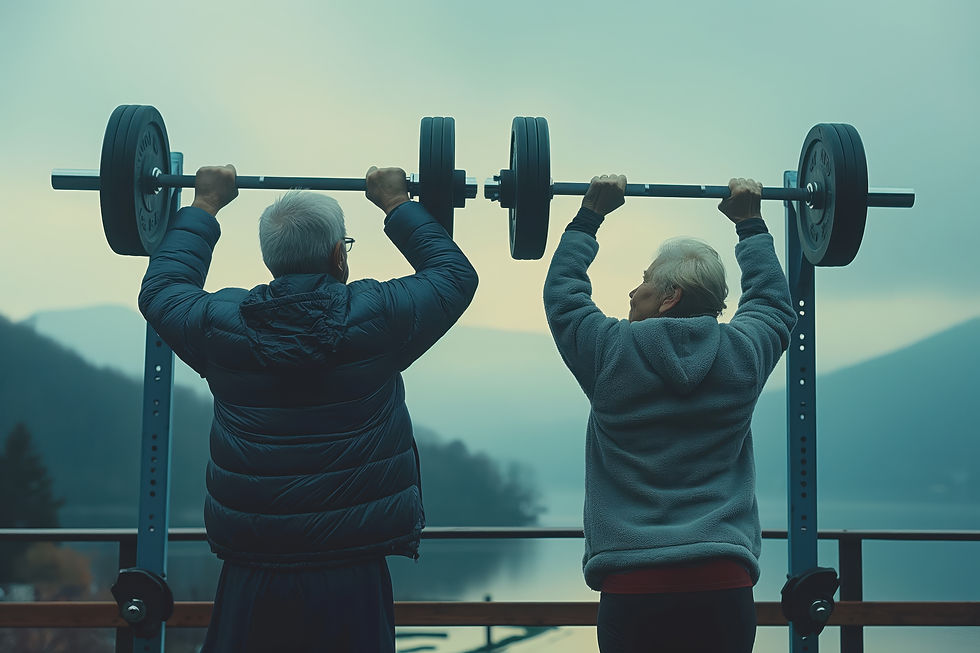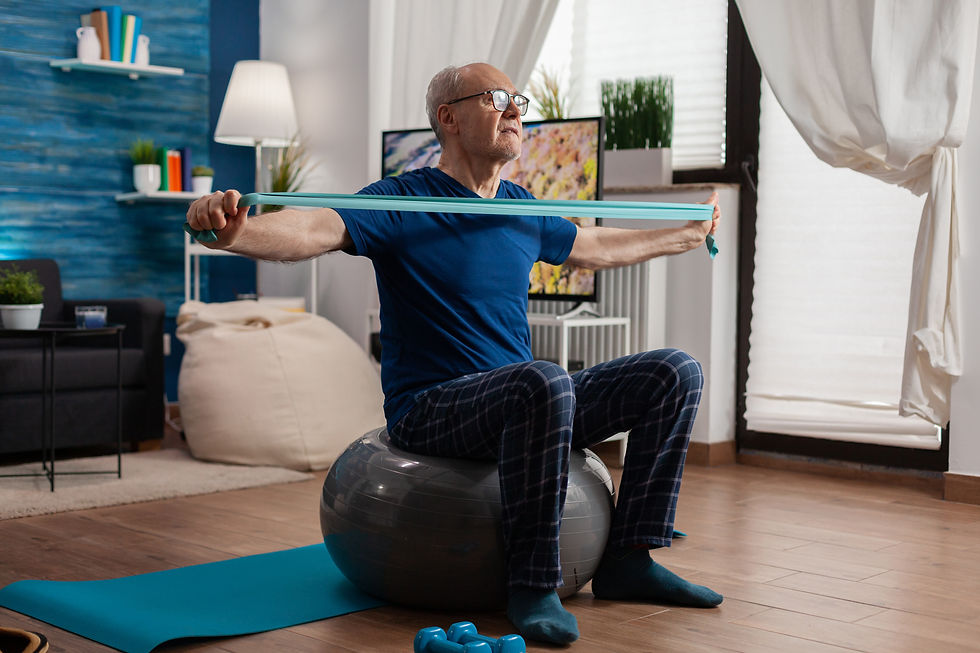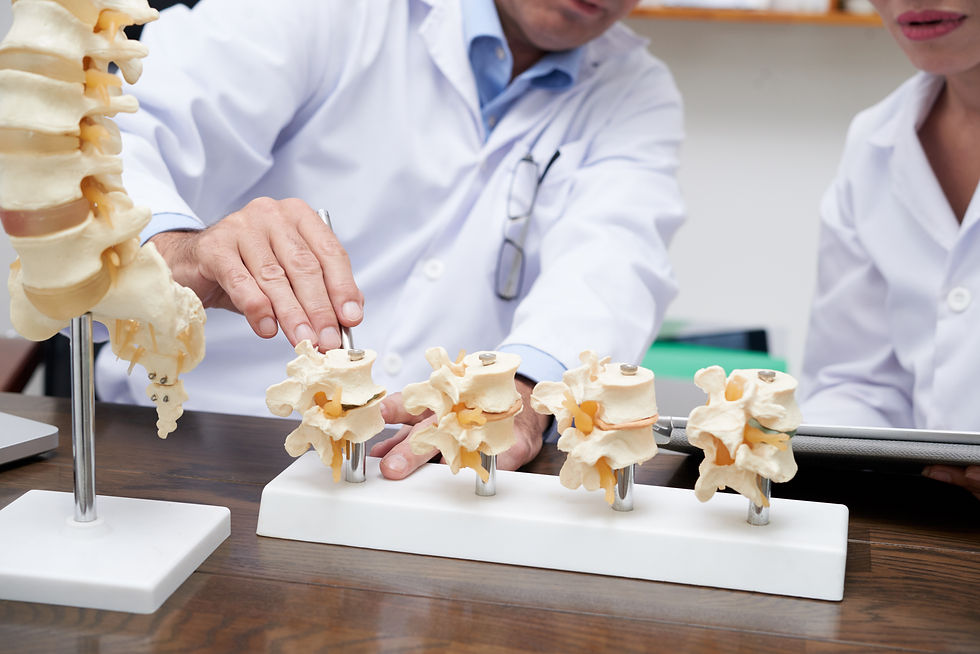Compressing Morbidity Through Exercise: How to Minimise the Gap Between Healthspan and Lifespan
- Jordan Pollard

- Apr 8
- 4 min read

We often think of longevity in terms of lifespan—the total number of years we live. But longevity means little if those extra years are spent in poor health, battling chronic disease, losing mobility, and relying on others for daily tasks. This is where healthspan comes in: the number of years we live in good health, free from significant disability or disease.
Unfortunately, for many people, there’s a decade or more of decline between healthspan and lifespan. The final years are often marked by frailty, cognitive decline, and multiple chronic conditions that diminish quality of life. This gap is what we aim to compress.
The goal isn’t just to live longer—it’s to live well for as long as possible, or better said, “live younger for longer”. This concept, called compressing morbidity, means reducing the period of decline so that we remain fully functional and independent until the very end. And the most powerful tool to achieve this? Exercise.
Lifespan vs. Healthspan: Understanding the Gap
The distinction between lifespan and healthspan is critical:
Lifespan = The total number of years you live.
Healthspan = The number of years you remain healthy, active, and independent.
On average, there is a 10-15 year gap between the two, where individuals suffer from chronic disease, loss of mobility, and a reduced ability to engage in the activities they love.
Why Does This Gap Exist?
The primary culprits are chronic disease, frailty, and loss of function, which often result from a lifetime of physical inactivity.
As we age, we experience:
Declining muscle mass (sarcopenia), leading to weakness and frailty.
Reduced cardiovascular fitness, making simple activities like walking or climbing stairs difficult.
Decreased balance and mobility, increasing the risk of falls and fractures.
Higher susceptibility to chronic diseases, including heart disease, cancer, diabetes, neurodegeneration (Alzheimer's), and cerebrovascular disease (stroke).
The good news? Exercise directly combats all of these factors.
The Science Behind Compressing Morbidity
Research consistently shows that regular physical activity is the single most effective intervention for extending healthspan.
Some key findings:
Exercise delays the onset of chronic disease by strengthening the heart, improving insulin sensitivity, and reducing inflammation.
Active individuals maintain higher levels of mobility and function well into old age.
Strength training prevents muscle loss, reducing the risk of falls and frailty.
Cardiovascular exercise protects against cognitive decline, reducing the risk of dementia and Alzheimer’s.
Regular movement reduces all-cause mortality, meaning active individuals are more likely to live longer and live well.
What We Learn from Centenarians
Studies on centenarians (those who live to 100+) and "super-agers" show a common trend: they remain physically active throughout their lives. Whether it’s daily walking, gardening, or structured exercise, movement is non-negotiable for aging well.
Why Exercise Is the Best Strategy for Extending Healthspan
Unlike medication, which often targets symptoms of disease, exercise treats the root causes of morbidity. It offers protection against nearly every major chronic condition, including:
Heart Disease: Exercise strengthens the heart, improves circulation, and lowers blood pressure.
Cancer: Regular activity lowers inflammation and strengthens the immune system.
Diabetes: Physical activity improves insulin sensitivity and helps regulate blood sugar.
Neurodegeneration: Exercise boosts brain-derived neurotrophic factor (BDNF), supporting cognitive function and reducing dementia risk.
Stroke & Cerebrovascular Disease: Movement improves blood flow, reducing the risk of blockages and strokes.
Perhaps most importantly, exercise preserves independence. It allows you to stay active, engage in hobbies, and continue daily tasks without relying on others.
The Ideal Exercise Prescription for Longevity
So, what’s the best way to train for longevity? The key is a well-rounded program that includes:
1. Strength Training (2-3x Per Week)
Prevents sarcopenia (muscle loss), keeping you strong and functional.
Supports bone density, reducing the risk of fractures and osteoporosis.
Improves metabolic health, enhancing insulin sensitivity.
Essential exercises: Squats, deadlifts, lunges, push-ups, and resistance band work.
2. Aerobic Exercise (150-300 Minutes Per Week)
Supports heart and lung function, reducing cardiovascular disease risk.
Improves brain health, boosting memory and cognitive function.
Activities: Brisk walking, running, cycling, swimming, or rowing.
3. Mobility & Balance Training (Daily)
Prevents falls and maintains agility.
Supports joint health and flexibility.
Activities: Yoga, dynamic stretching, and balance drills.
4. High-Intensity & Zone 2 Training (1-2x Per Week, each)
Zone 2 training (steady-state cardio) improves mitochondrial health, density, & function, and overall endurance.
High-Intensity Interval Training (HIIT) boosts cardiovascular fitness and metabolic function.
Activities:
Zone 2: cycling, brisk walking, jogging, or paddling.
HIIT: Interval sprints, circuit training, or hill sprints.
Implementing the Strategy: How to Start & Sustain a Longevity-Focused Routine
Start Where You Are
If you’re new to exercise, start small. Even 10-minute walks provide benefits. Focus on consistency over intensity.
The Concept of Progressive Overload
Your body adapts to exercise, so challenge it gradually. Increase weights, reps, or intensity over time to continue making progress.
Make Movement a Lifestyle
Use a standing desk or take walking breaks.
Choose active hobbies like hiking, dancing, or swimming.
Make social events activity-based (walking meetups, pickleball, cycling groups).
Track Metrics That Matter
Instead of focusing on weight alone, track:
Grip strength (a strong predictor of longevity).
VO2 max (cardiovascular fitness level).
Mobility and balance tests.
The Bigger Picture: Combining Exercise With Other Longevity Strategies
Exercise is the foundation of a long, healthy life—but it works best when combined with:
Sleep Optimization: 7.5-9 hours per night for recovery and cellular repair.
Nutrient-Dense Diet: Prioritizing protein and whole foods.
Stress Management: Meditation, mindfulness, and deep breathing.
Social Connection: Quality relationships have the single largest impact on longevity.
Conclusion: Aligning Healthspan With Lifespan
Aging is inevitable—but decline doesn’t have to be. By prioritizing movement, we can significantly compress morbidity, ensuring that we stay strong, independent, and fully functional until the very end.
The choice is simple:
Spend the last decades of your life battling disease, frailty, and dependence.
Or live vibrantly, maintaining strength, mobility, and mental sharpness for as long as possible.
The best time to start training for longevity was 10 years ago. The second-best time? Today.
So, what’s one physical ability you want to maintain at 90? Start training for it now.
Live Younger for Longer
If you're looking for expert guidance on optimising your health for longevity, my practice is dedicated to helping people move, feel, and live better for decades to come. Let’s start building your roadmap to 100 today!
Instagram: @pollardphysiology



Comments